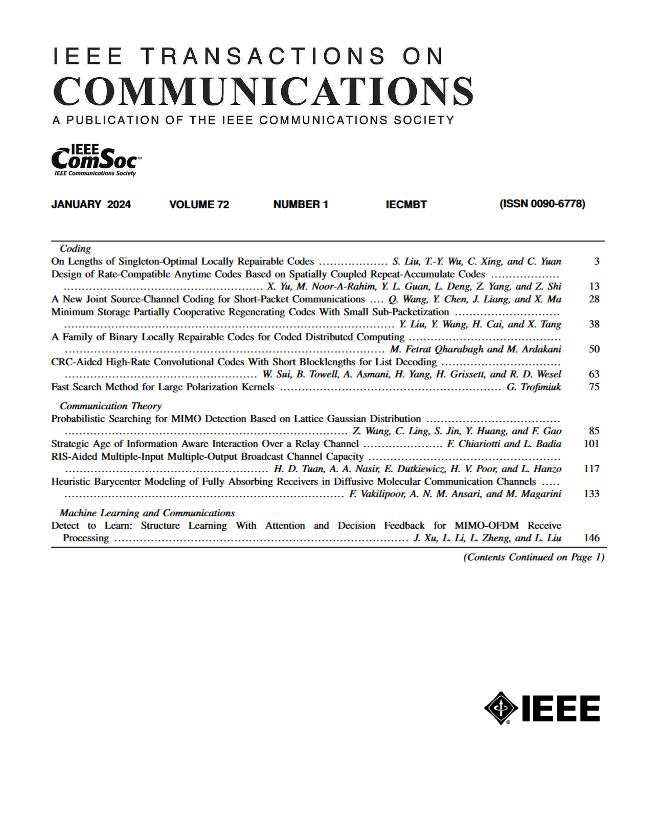PS-Net: Position-Based Precoding With Sensing Assistance for MIMO Downlink Transmission
IF 8.3
2区 计算机科学
Q1 ENGINEERING, ELECTRICAL & ELECTRONIC
引用次数: 0
Abstract
In frequency division duplex (FDD) massive multiple-input multiple-output (MIMO) communication systems, the base station (BS) requires channel state information (CSI) reported from user equipment (UE) for downlink precoding, which brings in significant feedback overhead. In this paper, we propose a position-based precoding method with sensing assistance to realize MIMO downlink transmission without CSI feedback from UE. By exploiting the location of UE and the information of the propagation environment provided by wireless sensing techniques, the BS is able to derive the precoder for downlink transmission. To achieve this, we devise a novel neural network (NN) structure called PS-Net (Position-based-precoding with Sensing-assistance Network), which includes an environmental feature extractor, a weight generation module, an adaptive position encoder, and a position-to-precoder mapper. Using the PS-Net, information about the scatters in the propagation environment can be extracted and fused with the UE’s location to realize position-based precoding for time-varying channels. We also propose a dedicated data augmentation method called random phase shifting to enhance the training data diversity, thus improving the generalization ability of PS-Net. Simulation results demonstrate the superiority of the proposed PS-Net compared with the existing feedback-based solutions and other position-based approaches in terms of spectral efficiency and communication overhead.PS-Net: MIMO下行传输的位置预编码与传感辅助
在频分双工(FDD)大规模多输入多输出(MIMO)通信系统中,基站(BS)需要从用户设备(UE)报告信道状态信息(CSI)进行下行预编码,这带来了巨大的反馈开销。在本文中,我们提出了一种基于位置的传感辅助预编码方法来实现MIMO下行传输,而不需要来自UE的CSI反馈。利用无线传感技术提供的UE位置和传播环境信息,BS能够导出下行传输的预编码器。为了实现这一目标,我们设计了一种新的神经网络(NN)结构,称为PS-Net(基于位置的预编码与传感辅助网络),其中包括一个环境特征提取器、一个权重生成模块、一个自适应位置编码器和一个位置到预编码器映射器。利用PS-Net可以提取传播环境中的散射信息并与终端的位置融合,实现时变信道的基于位置的预编码。为了增强训练数据的多样性,我们还提出了一种专用的数据增强方法——随机移相,从而提高PS-Net的泛化能力。仿真结果表明,与现有的基于反馈的方案和其他基于位置的方案相比,所提出的PS-Net在频谱效率和通信开销方面具有优势。
本文章由计算机程序翻译,如有差异,请以英文原文为准。
求助全文
约1分钟内获得全文
求助全文
来源期刊

IEEE Transactions on Communications
工程技术-电信学
CiteScore
16.10
自引率
8.40%
发文量
528
审稿时长
4.1 months
期刊介绍:
The IEEE Transactions on Communications is dedicated to publishing high-quality manuscripts that showcase advancements in the state-of-the-art of telecommunications. Our scope encompasses all aspects of telecommunications, including telephone, telegraphy, facsimile, and television, facilitated by electromagnetic propagation methods such as radio, wire, aerial, underground, coaxial, and submarine cables, as well as waveguides, communication satellites, and lasers. We cover telecommunications in various settings, including marine, aeronautical, space, and fixed station services, addressing topics such as repeaters, radio relaying, signal storage, regeneration, error detection and correction, multiplexing, carrier techniques, communication switching systems, data communications, and communication theory. Join us in advancing the field of telecommunications through groundbreaking research and innovation.
 求助内容:
求助内容: 应助结果提醒方式:
应助结果提醒方式:


